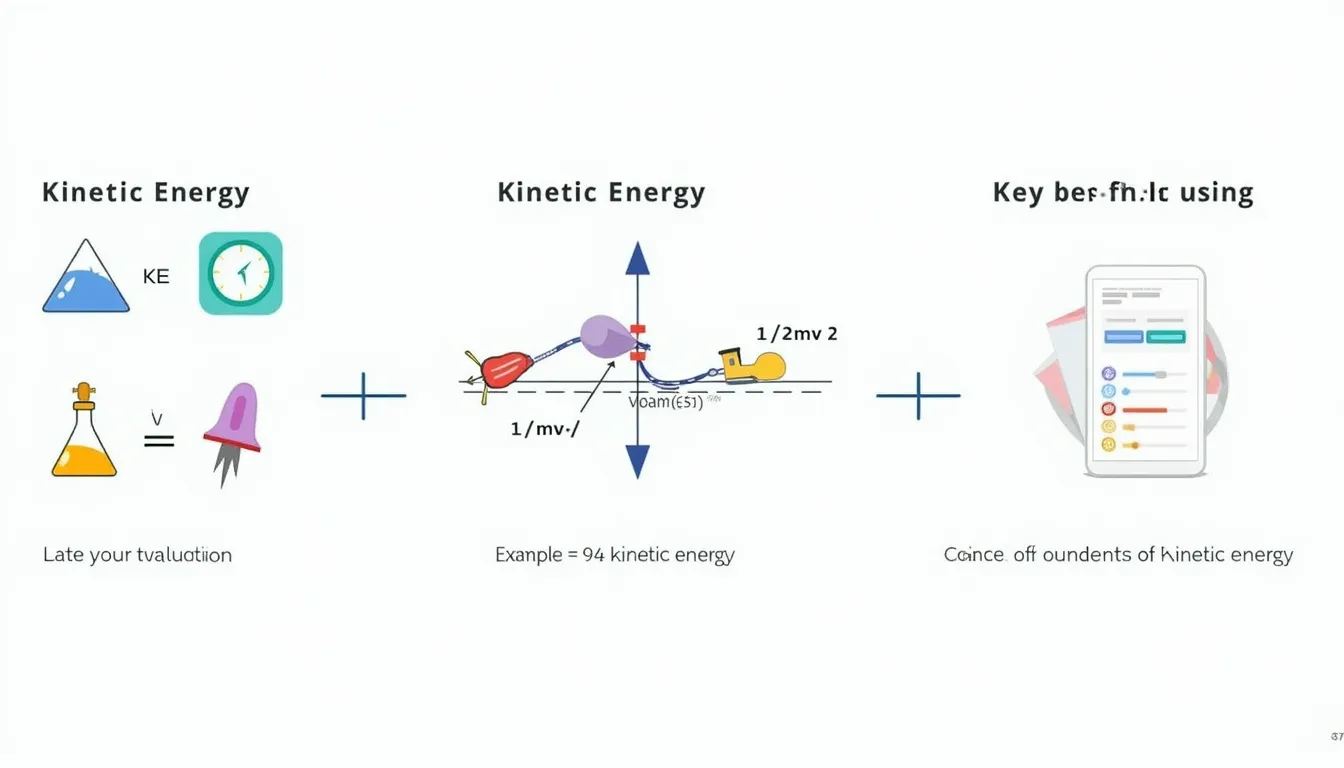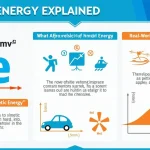Kinetic Energy Calculator
Is this tool helpful?
How to Use the Kinetic Energy Calculator Effectively
Our Kinetic Energy Calculator is a user-friendly tool designed to help you quickly and accurately calculate the kinetic energy of an object in motion. To use the calculator effectively, follow these simple steps:
- Enter the mass of the object in kilograms (kg) in the “Mass” field.
- Input the velocity of the object in meters per second (m/s) in the “Velocity” field.
- Click the “Calculate” button to obtain the result.
- The calculated kinetic energy will be displayed in joules (J) in the result section.
It’s important to ensure that you enter positive values for both mass and velocity. The calculator will alert you if you input invalid numbers, such as negative values or non-numeric characters.
Understanding Kinetic Energy: Definition, Purpose, and Benefits
Kinetic energy is a fundamental concept in physics that describes the energy possessed by an object due to its motion. It is defined as the work needed to accelerate a body of a given mass from rest to its stated velocity. The kinetic energy calculator serves multiple purposes and offers numerous benefits for students, educators, engineers, and physics enthusiasts alike.
Definition of Kinetic Energy
Kinetic energy is mathematically expressed as:
$$KE = \frac{1}{2}mv^2$$Where:
- KE is kinetic energy (measured in joules, J)
- m is the mass of the object (measured in kilograms, kg)
- v is the velocity of the object (measured in meters per second, m/s)
Purpose of the Kinetic Energy Calculator
The primary purpose of our Kinetic Energy Calculator is to simplify and automate the process of calculating kinetic energy. By providing a user-friendly interface and instant results, the calculator enables users to:
- Quickly determine the kinetic energy of moving objects
- Explore the relationship between mass, velocity, and kinetic energy
- Verify manual calculations and homework solutions
- Analyze real-world scenarios involving moving objects
- Support educational activities and demonstrations in physics classes
Benefits of Using the Kinetic Energy Calculator
Utilizing our Kinetic Energy Calculator offers several advantages:
- Time-saving: Eliminate the need for manual calculations, allowing you to focus on understanding concepts and analyzing results.
- Accuracy: Minimize human error and obtain precise results, especially when dealing with complex values or decimal places.
- Accessibility: Access the calculator from any device with an internet connection, making it convenient for both classroom and remote learning environments.
- Visualization: Gain a better understanding of how changes in mass and velocity affect kinetic energy through instant feedback.
- Versatility: Apply the calculator to various scenarios, from simple homework problems to complex real-world applications.
Benefits of Using the Kinetic Energy Calculator
Let’s delve deeper into the benefits of using our Kinetic Energy Calculator and explore how it can enhance your learning, teaching, or professional experience.
1. Enhanced Learning Experience
For students studying physics or related fields, the Kinetic Energy Calculator serves as an invaluable learning tool. It allows learners to:
- Experiment with different mass and velocity values to observe how they affect kinetic energy
- Verify their manual calculations, building confidence in their problem-solving skills
- Quickly generate multiple examples to reinforce their understanding of kinetic energy concepts
- Focus on interpreting results and understanding physical principles rather than getting bogged down in complex calculations
2. Efficient Problem-Solving
The calculator streamlines the problem-solving process by:
- Eliminating the need for repetitive manual calculations
- Allowing users to quickly test different scenarios and compare results
- Providing instant feedback, enabling rapid iteration and analysis
- Freeing up time to focus on higher-level problem-solving and critical thinking
3. Improved Teaching Tools
Educators can leverage the Kinetic Energy Calculator to enhance their teaching methods:
- Demonstrate kinetic energy concepts in real-time during lectures or online classes
- Create interactive exercises that engage students and promote active learning
- Develop more complex problems that focus on applying kinetic energy principles rather than calculation mechanics
- Provide students with a reliable tool for homework and self-study
4. Professional Applications
For professionals in fields such as engineering, physics, or sports science, the Kinetic Energy Calculator offers practical benefits:
- Quickly estimate kinetic energy in various scenarios, aiding in decision-making processes
- Perform rapid calculations during fieldwork or on-site assessments
- Verify complex computer simulations or theoretical models
- Communicate kinetic energy concepts to clients or team members effectively
5. Accessibility and Convenience
The online nature of our Kinetic Energy Calculator provides several advantages:
- Available 24/7 from any device with internet access
- No need to install specialized software or carry a physical calculator
- Regular updates ensure accuracy and compatibility with current standards
- User-friendly interface suitable for users of all skill levels
Addressing User Needs and Solving Specific Problems
Our Kinetic Energy Calculator is designed to address various user needs and solve specific problems related to kinetic energy calculations. Let’s explore how it caters to different user groups and scenarios:
Students and Learners
For students studying physics or related subjects, the calculator helps:
- Verify homework solutions and exam preparations
- Explore the relationship between mass, velocity, and kinetic energy through experimentation
- Visualize abstract concepts by providing instant numerical feedback
- Build confidence in understanding and applying kinetic energy principles
Educators and Teachers
Educators can utilize the calculator to:
- Create engaging demonstrations during lectures or online classes
- Develop interactive exercises that promote active learning
- Generate multiple examples quickly for comprehensive explanations
- Provide students with a reliable tool for self-study and practice
Engineers and Scientists
Professionals in technical fields can benefit from the calculator by:
- Performing quick estimations during project planning or feasibility studies
- Verifying complex computer simulations or theoretical models
- Analyzing energy transfer in mechanical systems
- Assessing safety considerations in scenarios involving moving objects
Sports Scientists and Coaches
In the field of sports and athletics, the calculator can be used to:
- Analyze the kinetic energy of athletes or equipment during various activities
- Optimize training regimens by understanding energy expenditure
- Assess potential injury risks associated with high-velocity impacts
- Compare performance metrics across different sports or events
General Public and Enthusiasts
For those with a general interest in physics or curious minds, the calculator offers:
- A simple way to explore everyday phenomena involving motion and energy
- An educational tool to better understand news articles or scientific reports related to kinetic energy
- A means to satisfy curiosity about the energy involved in various scenarios, from car crashes to asteroid impacts
Practical Applications and Use Cases
To illustrate the versatility and practical applications of our Kinetic Energy Calculator, let’s explore some real-world scenarios and use cases:
1. Automotive Safety Analysis
In the automotive industry, understanding the kinetic energy involved in vehicle collisions is crucial for designing safety features. Engineers can use the calculator to:
- Estimate the kinetic energy of a car traveling at different speeds
- Compare the energy involved in collisions at various velocities
- Analyze the effectiveness of crumple zones and other safety measures
Example: Calculate the kinetic energy of a 1500 kg car traveling at 100 km/h (approximately 27.78 m/s).
Using the calculator:
- Mass: 1500 kg
- Velocity: 27.78 m/s
- Result: KE = 578,703.70 J or approximately 578.7 kJ
This high value emphasizes the importance of safety measures in vehicle design and speed limits on roads.
2. Sports Performance Analysis
Sports scientists and coaches can utilize the Kinetic Energy Calculator to analyze and improve athletic performance:
- Measure the kinetic energy of a sprinter at different points in a race
- Compare the energy transfer in various throwing events (shot put, javelin, discus)
- Analyze the impact force in contact sports like football or rugby
Example: Calculate the kinetic energy of a 7.26 kg shot put thrown at a velocity of 14 m/s.
Using the calculator:
- Mass: 7.26 kg
- Velocity: 14 m/s
- Result: KE = 711.48 J
This information can help coaches optimize throwing techniques and training regimens.
3. Renewable Energy Assessment
In the field of renewable energy, particularly wind power, the Kinetic Energy Calculator can be used to:
- Estimate the energy potential of wind at different velocities
- Analyze the efficiency of wind turbines by comparing input and output energies
- Assess the feasibility of wind farm locations based on average wind speeds
Example: Calculate the kinetic energy of a column of air (mass 1000 kg) moving at 10 m/s.
Using the calculator:
- Mass: 1000 kg
- Velocity: 10 m/s
- Result: KE = 50,000 J or 50 kJ
This calculation helps in understanding the energy available for harvesting in wind power systems.
4. Space Exploration and Asteroid Impact Assessment
In the realm of space science, the Kinetic Energy Calculator can be applied to:
- Estimate the energy required for spacecraft maneuvers
- Assess the potential impact energy of asteroids or space debris
- Analyze the effectiveness of proposed asteroid deflection methods
Example: Calculate the kinetic energy of a 10,000 kg asteroid traveling at 20 km/s (20,000 m/s) relative to Earth.
Using the calculator:
- Mass: 10,000 kg
- Velocity: 20,000 m/s
- Result: KE = 2,000,000,000,000 J or 2 terajoules
This enormous value illustrates the devastating potential of even relatively small asteroid impacts and underscores the importance of asteroid detection and deflection research.
5. Educational Demonstrations
Physics teachers can use the Kinetic Energy Calculator to create engaging classroom demonstrations:
- Compare the kinetic energy of objects with different masses but the same velocity
- Illustrate the quadratic relationship between velocity and kinetic energy
- Demonstrate energy conservation principles in various scenarios
Example: Compare the kinetic energy of two objects with the same mass but different velocities:
Object 1:
- Mass: 5 kg
- Velocity: 2 m/s
- Result: KE = 10 J
Object 2:
- Mass: 5 kg
- Velocity: 4 m/s
- Result: KE = 40 J
This comparison clearly demonstrates that doubling the velocity quadruples the kinetic energy, helping students grasp the non-linear relationship between these variables.
Frequently Asked Questions (FAQ)
1. What is kinetic energy?
Kinetic energy is the energy possessed by an object due to its motion. It is defined as the work needed to accelerate a body of a given mass from rest to its stated velocity.
2. What are the units of kinetic energy?
Kinetic energy is typically measured in joules (J) in the International System of Units (SI). Other units may include foot-pounds (ft⋅lb) in imperial units or ergs in the CGS system.
3. How accurate is the Kinetic Energy Calculator?
Our calculator uses the standard formula for kinetic energy and provides results rounded to two decimal places. However, the accuracy of the result depends on the precision of the input values for mass and velocity.
4. Can the calculator handle very large or very small numbers?
Yes, the calculator can handle a wide range of values. However, for extremely large or small numbers, it’s recommended to use scientific notation to avoid potential input errors.
5. Why does the calculator only consider translational kinetic energy?
This calculator focuses on translational kinetic energy, which is the most common form encountered in everyday scenarios. Rotational kinetic energy requires additional parameters and is beyond the scope of this simple calculator.
6. How does kinetic energy relate to momentum?
While both kinetic energy and momentum are related to an object’s motion, they are different quantities. Momentum is the product of mass and velocity ((p = mv)), while kinetic energy is proportional to the square of velocity ((KE = frac{1}{2}mv^2)).
7. Can kinetic energy be negative?
No, kinetic energy cannot be negative. It is always positive or zero (when the object is at rest). This is why the calculator requires positive values for mass and velocity.
8. How does the calculator handle different units of measurement?
The calculator assumes that mass is entered in kilograms (kg) and velocity in meters per second (m/s). If you have measurements in different units, you’ll need to convert them before using the calculator.
9. Is this calculator suitable for relativistic calculations?
No, this calculator uses the classical formula for kinetic energy, which is accurate for everyday velocities but becomes inaccurate for speeds approaching the speed of light. Relativistic calculations require a different formula.
10. How can I convert the result to other units of energy?
The calculator provides results in joules (J). To convert to other units, you can use online conversion tools or multiply by the appropriate conversion factor (e.g., 1 J = 0.239 cal for calories).
Please note that while we strive for accuracy and reliability, we cannot guarantee that the webtool or results from our webtool are always correct, complete, or reliable. Our content and tools might have mistakes, biases, or inconsistencies.
Conclusion: Harnessing the Power of Kinetic Energy Calculations
Our Kinetic Energy Calculator is a powerful tool that simplifies complex physics calculations, making the concept of kinetic energy more accessible and applicable to a wide range of scenarios. By providing instant, accurate results, it empowers users to focus on understanding the principles of motion and energy rather than getting bogged down in manual calculations.
The key benefits of using this calculator include:
- Time-saving efficiency in problem-solving and analysis
- Enhanced learning experiences for students and educators
- Practical applications in various professional fields
- Accessibility and convenience for users of all levels
- Versatility in addressing a wide range of kinetic energy-related questions
Whether you’re a student grappling with physics homework, an educator seeking to engage your class, an engineer analyzing safety parameters, or simply curious about the energy involved in everyday motion, our Kinetic Energy Calculator is an invaluable resource.
We encourage you to explore the calculator, experiment with different values, and discover how kinetic energy plays a role in the world around you. By understanding and quantifying the energy of motion, we gain deeper insights into the fundamental workings of our physical universe.
Start using the Kinetic Energy Calculator today and unlock a new level of understanding in your physics journey. Remember, every moving object tells an energy story – our calculator helps you read it with precision and ease.
Important Disclaimer
The calculations, results, and content provided by our tools are not guaranteed to be accurate, complete, or reliable. Users are responsible for verifying and interpreting the results. Our content and tools may contain errors, biases, or inconsistencies. We reserve the right to save inputs and outputs from our tools for the purposes of error debugging, bias identification, and performance improvement. External companies providing AI models used in our tools may also save and process data in accordance with their own policies. By using our tools, you consent to this data collection and processing. We reserve the right to limit the usage of our tools based on current usability factors. By using our tools, you acknowledge that you have read, understood, and agreed to this disclaimer. You accept the inherent risks and limitations associated with the use of our tools and services.







